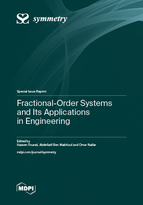Fractional-Order Systems and Its Applications in Engineering
A special issue of Symmetry (ISSN 2073-8994). This special issue belongs to the section "Mathematics".
Deadline for manuscript submissions: closed (31 December 2023) | Viewed by 16053
Special Issue Editors
Interests: automatic control; data fusion; navigation; machine learning applied in navigation; estimation and filtering; sensors for robotics
Special Issues, Collections and Topics in MDPI journals
Interests: fractional-order systems; stability analysis; stabilization; stochastic differential equations; existence and uniqueness; numerical simulations; fractional derivative; differential equations; fixed point theory
Special Issues, Collections and Topics in MDPI journals
Interests: mathematical models; control theory
Special Issues, Collections and Topics in MDPI journals
Special Issue Information
Dear Colleagues,
As data systems become more effective, more and more mathematical approaches have been applied to real-world applications to achieve exceptional outcomes. Fractional approaches (such as fractional calculus, fractional Fourier analysis, and the linear canonical transform) are gaining importance in the area of mathematics and the community of applied mathematicians. The theory and method of fractional domain analysis may further define the dynamic process of signal translation from time domains to frequency domains, creating a new avenue for non-stationary signal analysis and treatment study. In technical domains such as radar, communications, and sonar, fractional approaches are preferable to traditional integral methods because they bring novel concepts, procedures, and ideas. Due to the unpredictability of the sent signal in actual engineering systems and the effect of different disturbances and noises on the transmission process, despite the numerous benefits of these new fractional approaches, a few critical issues still need to be resolved. Simultaneously, fraction theory is confronted with several practical limits in engineering, such as sampling and filtering in the sphere of multidimensional signals. This Special Issue focuses on the current successes and potential difficulties of fractional techniques in engineering theory and applications. Novel studies and literature reviews are encouraged.
Potential topics include, but are not limited to, the following: analysis of the stability of fractional-order systems; the observability and controllability of fractional-order systems; an estimation of the states of fractional-order systems; fractional-order system stabilization; the identification of fractional models in continuous time; and medical imaging, radar, navigation, communications, genetics, and optical system applications of fractional approaches.
Dr. Hassen Fourati
Dr. Abdellatif Ben Makhlouf
Dr. Omar Naifar
Guest Editors
Manuscript Submission Information
Manuscripts should be submitted online at www.mdpi.com by registering and logging in to this website. Once you are registered, click here to go to the submission form. Manuscripts can be submitted until the deadline. All submissions that pass pre-check are peer-reviewed. Accepted papers will be published continuously in the journal (as soon as accepted) and will be listed together on the special issue website. Research articles, review articles as well as short communications are invited. For planned papers, a title and short abstract (about 100 words) can be sent to the Editorial Office for announcement on this website.
Submitted manuscripts should not have been published previously, nor be under consideration for publication elsewhere (except conference proceedings papers). All manuscripts are thoroughly refereed through a single-blind peer-review process. A guide for authors and other relevant information for submission of manuscripts is available on the Instructions for Authors page. Symmetry is an international peer-reviewed open access monthly journal published by MDPI.
Please visit the Instructions for Authors page before submitting a manuscript. The Article Processing Charge (APC) for publication in this open access journal is 2400 CHF (Swiss Francs). Submitted papers should be well formatted and use good English. Authors may use MDPI's English editing service prior to publication or during author revisions.
Keywords
- fractional differential equations
- observability, controllability, stability of nonlinear systems
- applications of fractional problems in engineering
- stochastic fractional-order systems
- variable-order differentiation and integration






